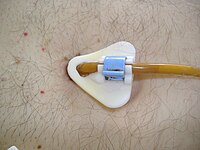
Photo from wikipedia
BACKGROUND Percutaneous endoscopic gastrostomy (PEG) tubes are removed and/or replaced for reasons such as tube malfunction, degradation, patient's device preference, and when stopping enteral feeding. AIMS To identify the types… Click to show full abstract
BACKGROUND Percutaneous endoscopic gastrostomy (PEG) tubes are removed and/or replaced for reasons such as tube malfunction, degradation, patient's device preference, and when stopping enteral feeding. AIMS To identify the types and rate of complications associated with traction removal of a PEG tube and if this is associated with the size of the PEG or length of time it had been in situ prior to removal. METHODS This retrospective study looked at the tube removal/replacement reports written by the Enteral Feeding Nursing Service over an 8-year period at a large teaching hospital trust in the north of England. FINDINGS The PEG tube removal reports of 127 patients were reviewed. Five types of complication were identified, categorised as retained bumper (5.5%); intraperitoneal placement of new device (3.17%); misplacement of replacement device into colon (a consequence of the insertion procedure not the removal of the PEG) (0.78%): gastrocutaneous fistula (0.78%); and inability to remove the tube (1.57%). The complication of retained bumpers was associated with an average length of time in situ prior to removal of the PEG tube of 29 months. In the cases of intraperitoneal placement, the PEG tube had been in situ for an average of 6 months. Nurses were unable to remove the PEG tube on two occasions; each had been in situ for approximately 4 years prior to attempted removal. CONCLUSION the complication rates are low following removal of a PEG tube using a traction pull. There was no clear correlation between length of time in situ or tube size and complication rate.
Journal Title: British journal of nursing
Year Published: 2022
Link to full text (if available)
Share on Social Media: Sign Up to like & get
recommendations!